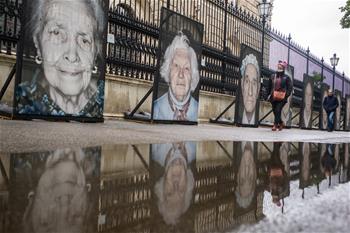ROME, May 18 (Xinhua) -- China's poverty reduction approach can serve as a useful model for developing countries around the world, United Nations (UN) experts and Chinese officials said at a seminar on poverty reduction.
The seminar took place at the third International Seminar on Global Poverty Reduction Partnerships held here during the 2019 International Cooperation Expo earlier this week.
The event was organized by three Rome-based UN agencies -- Food and Agriculture Organization, International Fund for Agricultural Development (IFAD) and World Food Program, together with China's International Poverty Reduction Center and China Internet Information Center.
Besides the experts and officials, it also involved representatives from various stakeholders, including the Asian Development Bank, Chinese e-commerce giant Alibaba Group, private sectors, governments and civil society.
China's efforts and results were presented and discussed at the seminar that focused on the role of technological innovation in reaching the Sustainable Development Goals (SDGs), especially SDG-1 and SDG-2 concerning poverty reduction and zero hunger.
"In the past six years, based on current standards, China has lifted 82.39 million rural poor out of poverty, with the rural poor population decreasing from 98.99 million in 2012 to 16.6 million in 2018," said Xia Gengsheng, vice minister of China's State Council Leading Group Office of Poverty Reduction and Development.
"The poverty rate has decreased from 10.2 percent to 1.7 percent (in the same period)," he said, noting that the Chinese government has set a goal to fully eliminate absolute poverty by 2020.
UN officials believe that one key factor that allows China to achieve such results is the ability to lay down a consistent political strategy.
"There are many aspects and many success factors in the Chinese story," Ashwani K. Muthoo, IFAD director of global engagement and multilateral relations division, told Xinhua on the sidelines of the seminar.
"One of the most important factors, in my opinion, is the political commitment to poverty reduction in rural areas, which is also backed by the allocation of resources," he said.
"Often, we see (countries outlining) good policies, but then these policies are not backed up by the resources required for transformation to take place," Muthoo said.
As China is working in line with a post-2020 strategy for poverty reduction already, Xia said over 3 million officials from higher-than-county level departments and public institutes were mobilized, adding to over 1.9 million committed officials in towns and villages.
One crucial task facing the authorities was to clearly define a targeted poverty alleviation strategy, Xia said, adding that six sub-systems were gradually established "covering accountability, policy implementation, fund management, mobilization, supervision and assessment for poverty alleviation."
"We made a lot of efforts to detect who the real poor were, where exactly they lived, and several other specific details. Then, we had to understand why they were poor, since there can be several different con-causes," the official said.
Once the overall picture was drawn and specific measures toward the target population were taken, the impact of the policies was assessed by third-party institutions, not directly by the government.
"We also have a strict system to evaluate the local authorities' efficiency in delivering policies. Local governments are held accountable for the results," Xia said.
This pragmatic approach is valuable and can be replicated in other developing countries, Xia said.
"China is a large country and when we started implementing the targeted poverty reduction policy, our poor population rate was about 10 percent, which means quite a huge number," Xia noted.
"The task of implementing tailored measures would be easier" in a smaller country, he said.
He said the availability of information technology has proved very useful for policy implementation. "Without the tools provided by technological innovation, our work would have taken a much longer time."
Xia said that while each country needs to set poverty reduction goals according to its own situation, the SDGs included in the UN 2030 Agenda provide a very helpful path.
"China has strictly stuck to the SDGs and has been exploring the approach to targeted poverty reduction for six years now. It has gathered a lot of experience and is willing to share with others," Xia said.
Muthoo said two other factors key to China's successful battle against poverty can serve as a good example for other countries.
"The first is the large infrastructure investment," he said.
"I have seen myself the infrastructures developed in China's rural areas, which are providing rural communities with access to markets, financial services, health services and education," he said.
The other is China's project planning and project implementation, and "the efficiency with which they do that," Muthoo added.
"In IFAD's experience, China is one of the countries where our projects function on time, mostly according to the delivery timelines and schedules," he said.

















